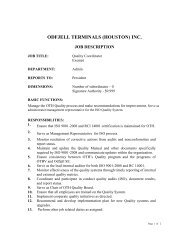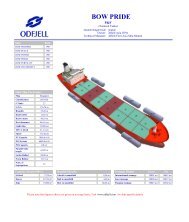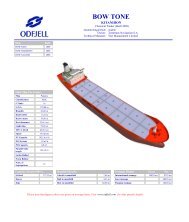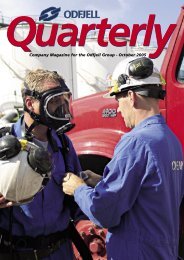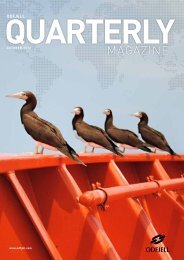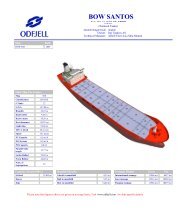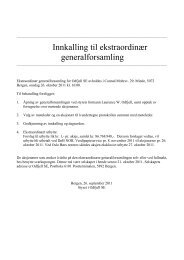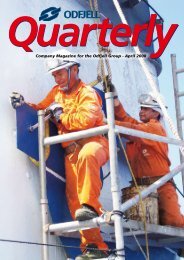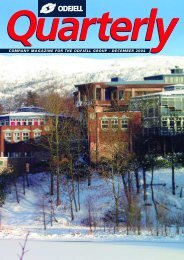Create successful ePaper yourself
Turn your PDF publications into a flip-book with our unique Google optimized e-Paper software.
New and improved Requirements<br />
and Guidelines Manual<br />
By Frode Stornes<br />
The Requirements<br />
and Guidelines<br />
Manual (RGM) is<br />
<strong>Odfjell</strong> Tankers’<br />
manual to ship<br />
managers and ships<br />
in which we describe<br />
“how to operate when<br />
in service for us”.<br />
The fleet consists of a mixture of<br />
owned and in-chartered ships as well<br />
as ships operated commercially on<br />
pool basis, and all the vessels are<br />
jointly providing services to our end<br />
customers.<br />
The manual may be put on the<br />
same footing as the managers’<br />
shipboard management systems<br />
and manuals.<br />
Distribution<br />
The former RGM has been<br />
available for <strong>Odfjell</strong> managed<br />
ships and third party managers<br />
for years. As a central element<br />
in the revitalisation of the<br />
RGM this year we wanted<br />
to extend the distribution.<br />
We wanted to encompass<br />
the third party ships and<br />
communicate directly with<br />
all the masters as well.<br />
Masters should have first<br />
hand knowledge of our<br />
expectation with regard<br />
to safety, efficiency<br />
and our operational<br />
procedures. Trilateral<br />
communication – between the<br />
masters, ship managers and the ship<br />
operators – based on one common<br />
reference book, must be beneficial to<br />
all the parties involved. The new and<br />
improved RGM (July <strong>2008</strong>) is therefore<br />
distributed to all time-charter owners,<br />
their managers as well as to the ships.<br />
<strong>Odfjell</strong> managed ships access it from their<br />
onboard systems and time-chartered<br />
ships have received it by a CD-room.<br />
Enhanced content<br />
The content is restructured and<br />
expanded by this revitalisation. The<br />
former RGM was largely concentrated<br />
on safety and equipment while<br />
the new RGM provides information<br />
and guidance about the organisation,<br />
operational requirements and systems<br />
as well as operational procedures.<br />
We transferred many of the instruction<br />
memos to the body text of the RGM.<br />
Unwritten best practices are pinned<br />
down, and QHSE is emphasised and<br />
pointed out in separate and prioritised<br />
chapters. Last but not least, it is<br />
structured in logical chapters:<br />
• Preface<br />
• Introduction<br />
• Quality<br />
• HSE<br />
• Cargo and Voyage<br />
• Vessel<br />
• Contingency<br />
• Ship Forms<br />
• Reference Documents<br />
One central document is Safety<br />
Elements/ Critical Operations in which<br />
we set forth detailed and functional<br />
requirements for the ship managers<br />
and ships to adhere to. In documents<br />
like Voyage Execution, Tank Cleaning<br />
Management and Bunkers Planning<br />
we set out requirements in addition to<br />
sharing best practices and describing<br />
systems and support function available<br />
for successful execution of the voyages.<br />
In the Bill of Lading document we give<br />
clear and comprehensive instructions<br />
to the masters how to do things right.<br />
Yet in other documents we describe<br />
various reporting routines. However<br />
cumbersome, that of documenting<br />
the voyages will never go out of style.<br />
Our requirements as to contingency,<br />
emergency preparedness as well<br />
as Reporting and Notification of<br />
Emergencies and Incidents are<br />
described in detail. The last main<br />
chapter is Ship Forms – the collection<br />
of document templates the ships shall<br />
use for reporting and documenting the<br />
voyages.<br />
Purpose<br />
The superior purpose of the manual is<br />
to ensure safe and efficient operations<br />
of all the ships operated by <strong>Odfjell</strong><br />
Tankers. The RGM should be used as a<br />
reference book onboard, as a reference<br />
in the trilateral communication between<br />
the master, the ship manager and the<br />
ship operator, as well as a verification<br />
“To have an easy<br />
to understand,<br />
structured and well<br />
documented RGM<br />
for our own fleet and<br />
time chartered fleet<br />
will clearly enhance<br />
<strong>Odfjell</strong> Tankers<br />
safety, quality, uniformity and<br />
reliability as a professional service<br />
provider”, says Sigmund Larsen,<br />
Senior Vice President Ship Operation.<br />
tool during ship visits, inspections and<br />
audits.<br />
Together with our ship inspections,<br />
mainly targeting ships by third party<br />
managements and furthermore<br />
integrating the RGM, the RGM forms an<br />
important element in our operational<br />
management.<br />
“Everybody working for <strong>Odfjell</strong>, ashore and onboard,<br />
shall bear in mind that the consequences of substandard<br />
performance often go far beyond monetary<br />
damages. It may for instance affect the safety of<br />
colleagues and damage customer relations. We feel<br />
confident that your fulfilment of the standards set<br />
forth in this Requirements and Guidelines Manual<br />
will result in a strong and sufficient degree of safety,<br />
consistent excellent service to our customers and will contribute<br />
positively to <strong>Odfjell</strong>’s market position and image”, says Jan Hammer,<br />
President / Chief Operating Officer of <strong>Odfjell</strong> Tankers AS in the preface<br />
of the manual.<br />
20 <strong>Odfjell</strong> <strong>Quarterly</strong> <strong>December</strong> <strong>2008</strong> <strong>Odfjell</strong> <strong>Quarterly</strong> <strong>December</strong> <strong>2008</strong> 21




